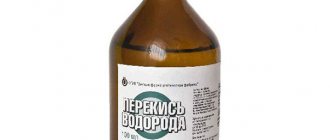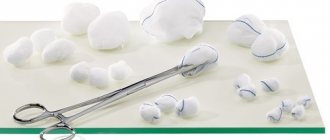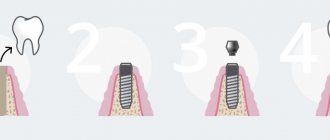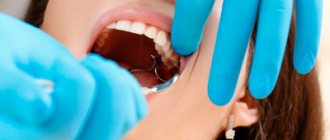Disinfection, which must be carried out after tooth extraction, is a mandatory condition for oral care. There are many antiseptics sold in pharmacies, but dentists often recommend using homemade, less aggressive remedies.
The use of soda solutions is a simple way to disinfect the wound formed at the site of an extracted tooth. Before manipulations, be sure to find out all the features and rules for using products with sodium bicarbonate as an active component, this will allow you to avoid unpleasant complications.
Features of rinsing the tooth after removal with soda
After tooth extraction, a deep wound remains. The first treatment is carried out by a dentist, disinfecting medications are used. Within a few hours, a dense blood clot forms on the wound, protecting the tissue from infection, dirt, and bacteria no worse than powerful medications.
Rinsing can wash away the natural barrier, so doctors do not recommend carrying out the procedure during the first 24 hours. Be sure to monitor the condition of the wound - if signs of inflammatory processes are noticed, begin manipulations using soda solutions earlier.
Expert opinion
Carefully!
Manipulations are recommended to be carried out carefully. Even if you use a composition in which the main component is baking soda, when rinsing, try not to disrupt the integrity of the blood clot. You should not vigorously roll the liquid in your mouth - this will inevitably lead to the displacement of the blood plug; it is better to just hold the solution in your mouth.
Be sure to use room temperature products. If the composition has cooled down, put it on the stove and heat it up. Perform wound disinfection procedures immediately after mixing the home remedy. Even short storage is enough for sodium bicarbonate to lose some of its medicinal properties.
Recommended for you:
How to treat thrush in men with soda: recipe, reviews
After the procedures, avoid eating solid, hot foods. Food particles will cause additional pain and dislodge the clot that protects the wound. Alcohol is no help here - alcohol will cause pain.
What to rinse with?
Keep in mind that you don't need to literally rinse your mouth.
, and arrange a therapeutic bath for the wound left
after tooth extraction
. So eliminate the efforts that create seething, so as not to damage the first healing processes.
- First aid
in this case is a solution of a teaspoon of salt and the same amount of soda in a glass of warm water. They are in every home. This rinse should relieve pain and disinfect the wound hole. - At the Pharmacy
you can always stock up on furatsilin to disinfect a sore spot. The solution requires one tablet per glass of water. A solution of chlorhexidine (0.05%) or miramistin is also suitable. The latter remedy also has a good analgesic effect. All medications are very inexpensive.
Many anti-inflammatory and disinfectant herbs, as well as those that have a healing effect, are suitable from your grandmother’s herbalist They are prepared in approximately the same way - cook a little for 15 minutes in a water bath, strain, cool and rinse. Chamomile, calendula, sage and eucalyptus are better suited than others, and it is better to use all at the same time in equal shares. You can also use St. John's wort, oregano and pine needles.- If
swelling
occurs the tooth was removed , then briefly apply ice to the sore spot and rinse the hole with soda and furatsilin. - If the pain occurs after removing the nerve of the tooth
, then rinsing with propolis infusion and the same soda solution, but with a few drops of iodine, helps a lot.
If after several days the pain does not subside, the bleeding does not stop, and any additional unpleasant symptoms arise, you should definitely seek help from a dentist. Another piece of advice: if you know that you have poor blood clotting, notify the surgeon about this and ask him to sew up the wound, having first put the medicine in the hole. This will facilitate and speed up the healing of the gums.
Sodium bicarbonate rinse
Baking soda is a substance often used to disinfect wounds. Dentists recommend performing manipulations only when removing a purulent tooth. Inflammatory processes occurring in the oral cavity are another reason to resort to an effective composition.
Soda recipe:
- Boil water (220 ml), cool to room temperature, hot liquid will reduce the effectiveness of NaHCO3.
- Combine warm liquid, sodium bicarbonate (15 g).
- Stir until all grains of powder disappear.
- Use immediately, reheat if necessary.
Rinse carefully - if you experience pain, simply hold the prepared liquid near the wound. Cotton wool soaked in soda will help stop the inflammatory processes - place a small swab on the site of the extracted tooth and leave for a quarter of an hour.
You should not exceed the recommended procedure time - NaHCO3 will begin to corrode the tissue, causing additional complications.
Soda-saline solution for gum inflammation
Expert opinion
Advice!
Infection in the wound, accompanied by inflammatory processes, is a reason to use a more aggressive agent. The combination of regular salt and NaHCO3 will stop the spread of infection, get rid of accumulations of pus, and relieve pain.
The first manipulations are unpleasant - the composition causes pain, so after using the product, rinse your mouth with plain warm water.
Preparation of the product, recipe:
- Mix salt (15 g), sodium bicarbonate (15 g).
- Pour warm water (200 ml) into the bulk mixture.
- Stir until the salt crystals completely disappear (they can cause irritation and damage the tissues of the oral cavity).
Rinse without vigorously rolling the liquid. Leave the solution on the affected area for a few seconds.
Recommended for you:
Why and how athletes take soda
Repeat the procedures 3-6 times a day. If after manipulation the blood clot begins to wash out and break down, reduce the number of procedures. Additionally, using brilliant green or iodine for cauterization is prohibited - this will lead to the formation of a burn to delicate sensitive tissues.
Iodine, soda against bleeding
Expert opinion
Attention!
The use of iodine in its pure form after tooth extraction is strictly prohibited, but the combination of baking soda and a pharmaceutical preparation allows you to quickly get rid of bleeding. Painful sensations also effectively disappear after 2-4 procedures performed at home.
Preparation of solution, application:
- Boil water (210 ml), wait until it cools.
- Add iodine (2-5 drops), stir.
- Add sodium bicarbonate (20 g).
It is recommended that manipulations with the solution be carried out every 2-3 hours. Bleeding will decrease in intensity after the first rinse, but there is no need to stop the procedures until the problem completely disappears.
Medicines from the pharmacy
It is better to use antibacterial and antimicrobial agents that do not contain alcohol. This way, you will protect the delicate tissue of the damaged gum from unnecessary burns.
- Miramistin.
It has the power to destroy bacteria, viruses, and fungi. You need to use a solution with a concentration of one hundredth of a percent. It is practically harmless. Suitable for babies and pregnant women. Use both as a solution and as a spray. Apply 3 times a day for a week.
- Chlorhexidine is
active against bacteria and some types of viruses. A solution with a concentration of no more than 0.05% is used. Miramistin is an order of magnitude cheaper. Maintains effect for up to 4 hours.
- Hydrogen peroxide
is a classic option. ITS three percent solution is a powerful antiseptic. However, use it yourself with caution. Contact with the wound produces foam, which can damage the blood clot. The liquid itself can cause irritation of the mucous membrane.
- Furacilin solution.
Used for purulent inflammation of the wound. In pharmacies it is available in liquid form and in tablets, from which you need to make a solution yourself. Crush 10 yellow tablets and dissolve in a liter of water. Rinsing is not recommended; it is better to use baths.
You can use decoctions
from chamomile
,
calendula, oak bark, sage, St. John's wort and eucalyptus.
On the effectiveness of anti-inflammatory herbs
in
In this case, you need to consult a dentist.
If the wound after tooth extraction is large and there is a risk of damaging the blood clot, it is better to prefer baths to rinses.
Take a sip of the solution into your mouth, maintain the liquid in the wound area and spit it out.
Attention! Do not use potassium permanganate. Reasonable people abandoned it long ago - it burns mucous tissue.
Herbal decoction for rinsing
A decoction of plants will help relieve the painful sensations that arise after a visit to the dentist. To increase efficiency, it is recommended to add NaHCO3. Use a composition based on sodium bicarbonate, despite severe pain, one day after tooth extraction.
Preparation, use:
- Grind dry sage (20 g), rub with your hands, turning it into a fine paste.
- Brew the vegetable pulp with boiling water (240 ml), leave, cover with a lid to obtain a rich decoction.
- Baking soda is added after filtering - 15-18 grams are needed. cooking powder.
It is recommended to prepare a large portion of the broth, adding soda before rinsing. Store the herbal remedy in the refrigerator, heat it up before use, and use the microwave.
If the body reacts negatively to sage, replace the plant with chamomile inflorescences, which have disinfectant and analgesic properties. At the same time as disinfecting the wound, chamomile infusion will relieve pain.
Recommendations after tooth extraction
- Stopping the bleeding. Immediately after the procedure, the empty socket will bleed. This is normal for the first 30-60 minutes. A blood clot should then form on the surface of the wound. At the end of the procedure, the doctor places a tampon on the empty hole to heal it and stop the bleeding. Keep the tampon in place for at least 20 minutes. If the bleeding does not stop, increase this time to 40-50 minutes. You can’t just leave a tampon in place: bacteria will begin to accumulate under it. If the bleeding does not stop within an hour, consult a doctor. Perhaps there is a fragment of root left in the gum; this option is especially relevant for wisdom teeth.
- Pain relief. When the painkiller wears off, you may experience some discomfort in your mouth. If they keep you from sleeping or are simply uncomfortable, you can take a pain reliever. Which medicine should be used - check with your dentist before or after the procedure, but do not do it on your own! Be sure to follow the instructions on the package: do not exceed the permissible dosage.
- Baths instead of rinses. Do not touch the socket for 24 hours after tooth extraction. Any, even the most harmless intervention can seriously harm. Do not touch the wound with your tongue, avoid rubbing the toothbrush or getting pieces of food into the wound. This will delay the healing process and can cause gum inflammation. After 24 hours, you can begin medicinal baths as recommended by your doctor for the next 3-5 days. Herbal decoctions are suitable for this: chamomile or calendula. You can also use medicines: chlorhexidine, miramistin and others. The essence of the baths is to retain liquid in the mouth for up to 20 seconds. In this case, there is no need to rinse the mouth, otherwise you can wash the blood clot out of the hole.
- Care of the cavity after tooth extraction. Despite surgery, your teeth still need to be cared for and cleaned. During the first 24 hours after tooth extraction, you should refrain from brushing. Next, carry out it no less carefully than before the procedure. It is important to clean the teeth in the vicinity of the empty socket without touching it. Use a soft toothbrush.
- Eating. You can eat and drink within a couple of hours after removal. The food should be soft so as not to damage the wound. Avoid eating nuts, seeds and other similar foods. If possible, avoid chewing with the side on which the tooth was removed.
- Cold compress. Can be used as desired. Cold will reduce the risk of swelling and inflammation, constrict blood vessels and relieve pain. We recommend applying a compress through gauze or a cloth for no more than 20-25 minutes. This is enough to improve your well-being and prevent hypothermia.
- Overheating failure. For three days, avoid hot baths, steam baths or saunas, or prolonged exposure to direct sunlight. Overheating is dangerous due to vasodilation, which can lead to bleeding and the onset of an inflammatory process.
- Abstinence from alcohol and tobacco. It is advisable to give up these habits the day before the procedure and for a couple of days after. This will speed up the healing process. Tobacco can cause bleeding and infection of the socket. Alcohol thins the blood and prevents the wound from healing. When taking antibiotics, you will have to avoid alcoholic beverages for a longer period.
- Refusal of physical activity. We recommend that patients give up sports for at least a day after tooth extraction. The reason is a possible increase in blood pressure, increased blood flow and, as a result, possible bleeding. Exercise and long walks do not fit the restrictions.
- Hole control. Monitor the healing process. If the pain lasts for several days, the wound periodically bleeds, the temperature does not subside, swelling appears, then inflammation is possible. In this case, contact your dentist; do not self-medicate.










